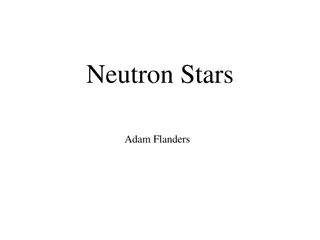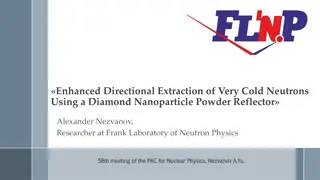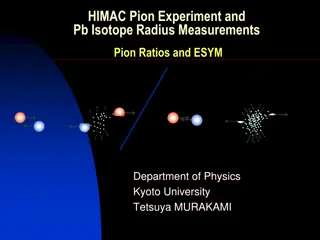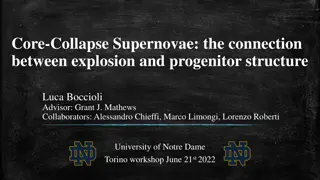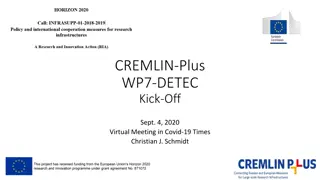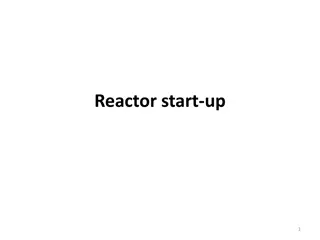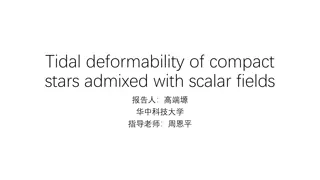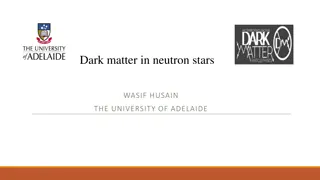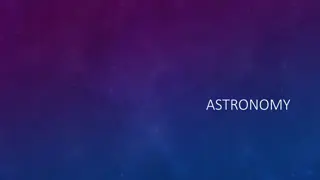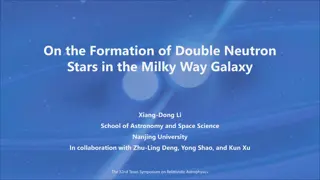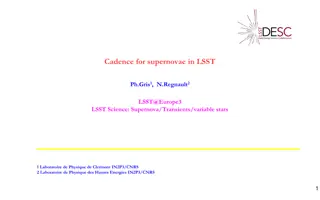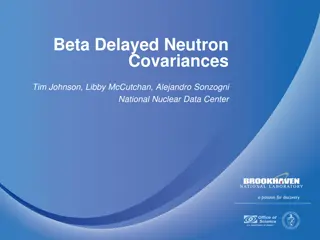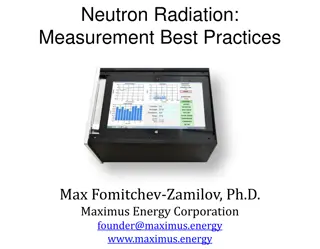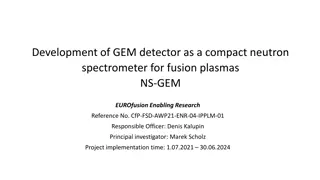The Physics of Supernovae and Neutron Stars
Explore the fascinating world of supernovae and neutron stars through historical postulations, Nobel Prize-worthy discoveries, multi-dimensional simulations, and paradigm shifts in understanding asymmetric supernovae. Dive into the complexities of core-collapse mechanisms, jet formations, and the potential role of jets in boosting energy and luminosity. A comprehensive look at the evolution of our understanding of these cosmic phenomena.
Download Presentation

Please find below an Image/Link to download the presentation.
The content on the website is provided AS IS for your information and personal use only. It may not be sold, licensed, or shared on other websites without obtaining consent from the author.If you encounter any issues during the download, it is possible that the publisher has removed the file from their server.
You are allowed to download the files provided on this website for personal or commercial use, subject to the condition that they are used lawfully. All files are the property of their respective owners.
The content on the website is provided AS IS for your information and personal use only. It may not be sold, licensed, or shared on other websites without obtaining consent from the author.
E N D
Presentation Transcript
Physics of Supernovae Pauli (1934) Neutrino postulation Bethe & Peierls (1934) - If [there are no new forces] one can conclude that there is no practically possible way of observing the neutrino Baade & Zwicky (1934) stars collapsing into neutron stars With all reserve we advance the view that a super-nova represents the transition of an ordinary star into a neutron star, consisting mainly of neutrons. Such a star may possess a very small radius and an extremely high density Supernovae, neutron stars, cosmic rays Reines & Cowan (1956) neutrinos detected, using a nuclear reactor; Reines, Nobel Prize 1995 (Cowan died in 1974) Bahcall (1964) - Only neutrinos, with their extremely small interaction cross sections, can enable us to see into the interior of a star... Colgate & White (1966), Wilson (1985), Colegate & White (1985) delayed neutrino mechanism neutrino heating revives stalled shock thereby exploding the star 1987 - nearby Supernova 1987A; Davis and Koshiba, 2002 Nobel Prize
Core-Collapse, Does it Work? Multi-Dimensional Simulation To Explode or, Not 1-D: Most do not explode, except an 8.8 Mo model 2-D: similar to 1-D 3-D: Some found it makes it easier (e.g. Mezzacappa group), some found it harder (e.g. Janka group) Instability, Asymmetry Explosions of ~ 0.3 0.9 foe (Mezzacappa et al.) 10foe? (Do not exists in theory) Rotation (some say it is not important) Magnetic Field (Le Blanc & Wilson mechanism; Wheeler et al. 2000) related to rotation
No current simulation has produced a successful 1051 erg supernova.
Asymmetric Supernovae - Paradigm Shift? Polarimetry Neutron Star Kick SN 1987A Do Jets occur in SNe?
One simple model Jets: Relativistic GRB . .. . Jets: Supersonic Normal SNe? Khokhlov et al. 1999 Supersonic jets Magnetorotational Does not depend on neutrino Angular momentum barrier Jittering-Jet (Papish & Soker 2011, 2014)
What Can a Jet Do? A GRB An Explosion? Beamed Neutrino? Boosted energy Boosted luminosity/Beaming
Observations SN 1987A Pulasar kick Polarimetry
SN 1987A Bocchum event (Hanuschik et al. 1988) CSM Ring (Wang et al. 1991) HST Imaging and Kinematics (Wang et al. 1996) VLT SIFONI Data (Larsson et al. 2013) ALMA
Really? Green Radioactive deposition Violet Far-Infrared Cyan Optical McCray, in prep
Asymmetry Creates Polarization Photosphere Ca II e- e- e- e- e- e- e- e- e- e- e- e- e- Line forming, scattering atmosphere Distorted Photosphere: Continuum/line Polarization Spherical Photosphere Spectral line polarization only
The Concept of Dominant Axis (N) I90 U I135 I45 I0 (E) Q Q = (I0-I90)/(I0+I90) U = (I45-I135)/(I45+I135) I90(N) U I135 I45 I0(E) Q
2-D vs 3-D? If we maintain that CCSNe are neutrino- driven, it may be logical to assume that we are missing something essential in the neutrino sector. Mezzacappa et al. 2015
Observational Constraints - What can JUNO do? Shock Breakout
It takes 20 min 2 hours for the shock to breakout of the surface of the star Enough time to alert ground-based optical network
Optical Followup XIAN (York, Wang, et al. 2008) eXtreme Imaging Antarctic Network
XIAN -AST3
Optical Followup ~20000 30cm aperture 1 1/3*10000. 40000. 0.7 5% 2 18000. 40000. 0.7 30% 17 mag in 10 min
Follow up observations AST3 can follow any candidates during Austral winter Small telescope networks (LCOGT etc) LSST ASKAP (Radio; SKA Prototype)
But they would not work The progenitor stars are very small in size The shock breakouts are very hot AST3, XIAN, PANSTARRs, LSST etc, are unlikely to catch the initial burst in the wavelength you want to observe Gamma; X-ray; UV Swift?
Optical Followup Neutrino Trigger Wide field rapid follow up For Supergiant (Type IIp) up to 2 hour For WR Stars (Type Ib/c) ~ 10 minutes Chevalier 2008
Summary Neutrino detection is critical for supernova physics Supernova physics may be missing some important physics, about neutrinos or about driving mechanisms In the future, optical follow up can be done within minutes after JUNO trigger, but the best observing window is not in the optical UV observations reveals the surface of the stars, and the temperatures of the shock breakout Soft X-ray? (Shock breakout; Blue Supergiant such as of SN 1987A; CSM interaction) Gamma? (Radioactive decay)


